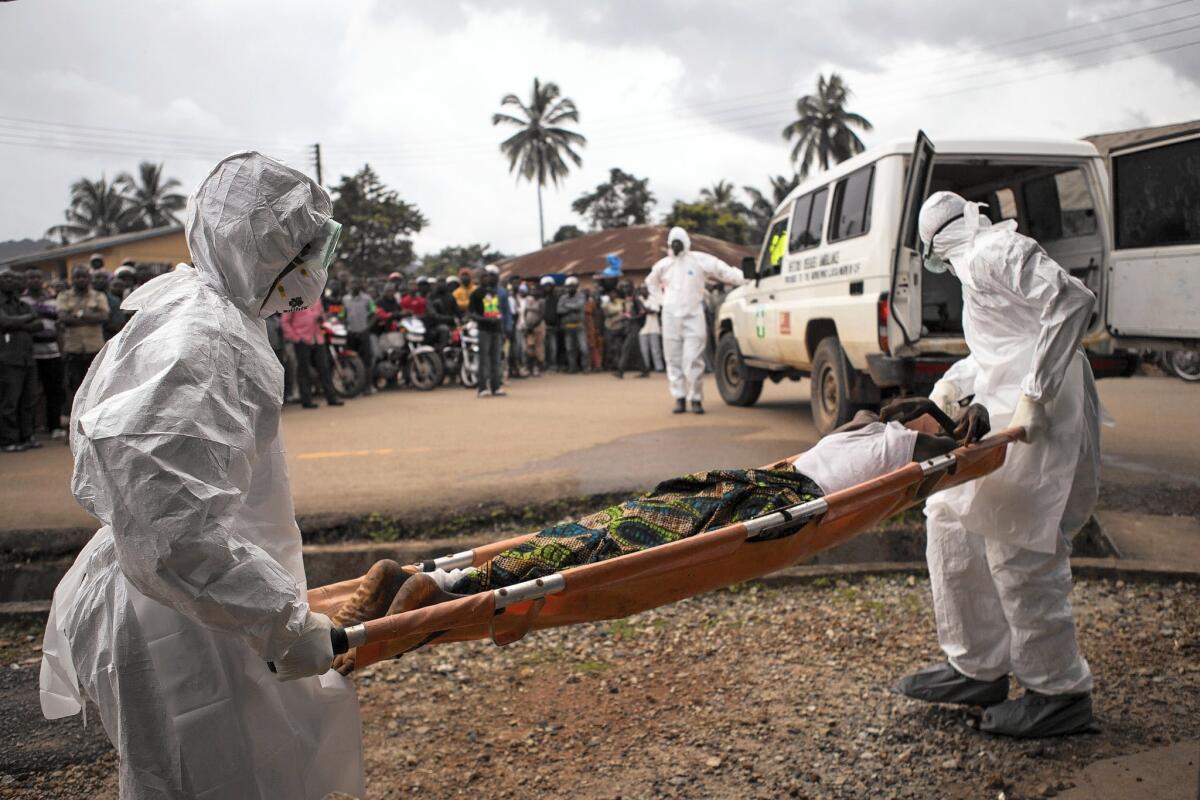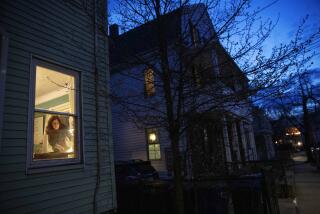Isolation can take emotional toll on volunteers at risk of Ebola

Dr. Matthew Waxman recently returned to Los Angeles after spending nearly two months in the town of Lunsar, Sierra Leone, where he treated Ebola patients at an isolated medical facility.
He and colleagues toiled in harsh and stressful conditions, caring for people “the best we could.” In the quiet stretches between intense bursts of drama and terror, they talked about the reception that would await them at home — at times with a degree of dread, since some returning medical workers have had less than enthusiastic welcomes.
“It’s a lot of anticipation over warm African beers at night,” Waxman said. “What will it be like in my county?”
Medical workers and their reentry into everyday American life became a concern last fall after two Dallas nurses and a New York physician volunteer fell ill following close contact with Ebola patients.
Some officials called for mandatory quarantines for returning medical workers. Others wondered whether such restrictions would stigmatize volunteers and discourage them from heading to Africa, where they were sorely needed to stop the spread of Ebola. In a report released Thursday, a presidential bioethics panel cited such concerns and urged public health organizations to “employ the least restrictive means necessary” based on scientific evidence.
In Los Angeles and throughout the U.S., state and local health departments, using U.S. Centers for Disease Control and Prevention guidelines as a starting point, are responsible for deciding how to monitor travelers coming from Guinea, Liberia and Sierra Leone. Imposing varying levels of restriction, staff members track anyone who may have been exposed to Ebola, keeping tabs on them throughout the virus’ 21-day incubation period and looking out for fevers and other symptoms of illness.
During the first 12 weeks of Ebola monitoring in the U.S., local officials tracked about 7,000 people nationwide, including close to 200 in California, said Rachel Nonkin Avchen, an epidemiologist at the CDC who works on monitoring efforts.
In Los Angeles County, health officer Dr. Jeffrey Gunzenhauser said that the public health department has monitored about 50 travelers arriving from West Africa, including a handful of medical workers such as Waxman who had direct contact with Ebola patients.
The department bases its approach on the CDC recommendations, which call for various types of monitoring based on a returning traveler’s risk level — generally reserving tougher restrictions such as quarantines for those at the highest risk.
Gunzenhauser said the health officer for the state of California requires him to issue a quarantine order for any traveler who has had contact with an individual with Ebola, but that he can tailor those restrictions based on the actual level of risk. About 30% of jurisdictions in the country routinely opt for more restrictive monitoring practices than those in the CDC guidelines, Nonkin Avchen said.
For the 41-year-old Waxman, who just over two weeks ago was treating patients at a facility operated by the relief organization International Medical Corps, waiting out Ebola’s incubation period has been a “surreal” but quiet process of readjusting to semi-normal life.
An order signed by Gunzenhauser requires Waxman, who is considered to be at “some risk,” to cooperate with department monitors, to stay in Los Angeles County and to stay away from work and commercial or public transportation through Wednesday. The doctor has been spending his days telecommuting, working on research and paperwork for his job as an emergency physician at Olive View-UCLA Medical Center.
“I basically spend most of my time at home,” he said.
A public health nurse checks in with Waxman twice a day — once over videoconference, once by phone — to monitor his temperature and symptoms. As long as he does not have a fever of 99.5 degrees or higher, or have any symptoms that could be early signs of illness, Waxman is allowed to care for his young child and to leave his house in Silver Lake for six hours until his next temperature check. He has gone grocery shopping and has walked his son to school.
With the exception of the doctor in New York, none of the travelers who have been monitored for Ebola in the U.S. have developed the disease, Nonkin Avchen said.
Gunzenhauser said the lack of additional cases in the U.S. shows that healthcare practices now in use in West Africa are working to protect medical workers, and that it takes a significant level of exposure to get another person sick. Ebola spreads through close contact with bodily fluids, and only when victims are symptomatic.
“The risk of a healthcare worker coming back and developing Ebola — and if they develop illness, the risk of them transmitting the virus early in their illness — is very low,” he said. “As the health officer I have the duty to protect public health, but I have to balance it against the rights people have.”
Waxman said Gunzenhauser and the health department have been “really fair” throughout his reentry process.
But he said he was finding it “difficult to adjust to the lack of intensity and sense of purpose here, and to the absurdity we all love and hate about Los Angeles.”
Colleagues were sending updates from Sierra Leone, where people were still dying from the epidemic. If his son didn’t need him at home, Waxman said, he’d already be making plans to go back.
eryn.brown@latimes.com
Twitter: @LATerynbrown
More to Read
Sign up for Essential California
The most important California stories and recommendations in your inbox every morning.
You may occasionally receive promotional content from the Los Angeles Times.











